Imperial Japanese Aircraft Carrier Zuikaku - 1944

Reviewed by Dan Kaplan

| HISTORY | ||||
|
Zuikaku's design and history closely mirrors that of her sister ship, Shokaku. Zuikaku ("Fortunate Crane") and her sister were 4th generation aircraft carriers of the Imperial Japanese Navy, completed almost literally on the eve of the Pacific war in the fall of 1941. Their design incorporated all the prior lessons of Japanese aircraft carrier design and operational experience, and was unencumbered by any restrictions of the Washington Naval Treaties, as Japan had withdrawn her participation by the time of this carrier's design. The result was a very large, purpose-built aircraft carrier of 32,000+ tons full load displacement, with a superior balance of high speed, large aircraft capacity, armor protection, heavy AA weaponry, and large radius of action. By almost any measure, the design can be considered highly successful and the sisters are considered the most effective of all the Imperial Japanese Navy's aircraft carriers. Aesthetically, they are considered among the sleekest and handsomest of the Japanese CVs. At the time of completion, the sisters were deemed by the IJN as far superior to any other aircraft carrier then afloat. They were robust & durable ships, as demonstrated by sister Shokaku's twice surviving a major attack with considerable damage by multiple, heavy bomb hits. They were large enough to accommodate a substantially sized air wing, even as aircraft size and weight increased throughout the war. The same is true for accommodating large increases in antiaircraft defenses and the addition of radar, along with the requisite increase in crew size. The sisters were a critical component of the IJN's naval air arm and were a participant in virtually every major carrier clash in the Pacific, save Midway. After Midway, they were THE major aircraft carrier component of the IJN. Zuikaku was laid down at the Kawasaki, Kobe shipyard on May 25, 1938, launched on November 17, 1939, and commissioned on September 25, 1941. She then joined her sister ship Shokaku that fall to form Carrier Division 5 and embarked on a short period of intense training in preparation for the Pearl Harbor attack. As one of the six fleet carriers of the Kido Butai (First Air Fleet), Zuikaku participated in the Pearl Harbor operation, the January 1942 raid on Rabaul and against airfields around New Guinea, several sorties from Japanese waters to counter real and imagine enemy incursions in early 1942, the Indian Ocean raid & the Battle of the Coral Sea, generally considered the first carrier versus carrier battle in history, in which opposing fleets never saw each other. At the Coral Sea, steaming several thousand meters ahead of Shokaku, she fortuitously escaped any damage from US air attack by steering into a nearby rain squall for cover while Shokaku bore the brunt of the attack. In turn, Zuikaku's dive bombers inflicted all three bomb hits on USS Yorktown. Though she avoided physical damage, her air group suffered heavy losses, particularly among the dive bombers and attack/torpedo bombers. After the battle, Zuikaku returned to Japan to replenish her air groups. Without a viable air group with which to participate, she missed the debacle at Midway, though Zuikaku did sortie afterwards with other units to briefly support the ending phases of the Aleutian Operation. Rejoining repaired Shokaku in mid August 1942 as part of the reconstituted 1st Carrier Division, she and her sister became the backbone of the IJN carrier fleet. Just prior to returning to duty, she entered drydock at Kure for a brief refit, including the addition of several more triple 25mm mounts and crew compartments at the bow (2),stern (2), and two more such mounts on the flight deck, one each ahead and behind her island. Zuikaku was necessarily involved in support of Japanese efforts at Guadalcanal. First, in late August, 1942 at the Battle of the Eastern Solomons and then again in October at the Battle of Santa Cruz, the 1st Carrier Division was the focus of much of the fighting. Her air groups inflicted much damage upon her opponents USS Enterprise (Eastern Solomons), and subsequently USS Hornet (Santa Cruz), while Zuikaku again escaped without damage. She arrived back in Japanese waters that November, again entering drydock at either Kure or Yokosuka. She gained a new Type 21 radar atop her island bridge while re-situating the Type 94 HA director originally in that position to the forward port side boat deck, just aft the director already in position there. (This setup essentially mirrored the layout of the two Type 94 HA directors on the starboard side, outboard of the island.) Another, retractable, Type 21 radar unit was emplaced, possibly in this same visit, in a position on her portside, aft flight deck. Bereft of her very badly damaged (again) sister Shokaku, Zuikaku helped cover the evacuation of Japanese forces from Guadalcanal in very early 1943. Air group training occupied most of the spring of 1943 while the latter half of the year saw her join a series of fleet movements, feints and responses to American raids and advances across the Pacific. After a brief refit in very early 1944, which again included the addition of two more triple 25mm AA mounts to the bow (1) and stern (1), Zuikaku continued with more training for her air groups as well as ferrying aircraft to Singapore. She remained in the general vicinity of Singapore during the early spring until joined at the Tawi Tawi anchorage in May by the other members of the revised 1st Carrier Division, Shokaku and Taih?, as well as a significant portion of the Japanese fleet. Zuikaku sortied with CarDiv 1 and the First Mobile Fleet under Admiral Ozawa in response to US landings in the Marianas Islands in June. US and Japanese carrier forces subsequently met and clashed in the epic carrier battle known as the Battle of the Phillipine Sea, June 19-20. Yet again, she escaped from significant damage while Shokaku, Taiho and Hiyo (CarDiv 2) all succumbed to torpedo attack by US submarines. Zuikaku's air group, along with those of her division mates, attempted to attack US forces but was effectively rebuffed. As the lone surviving carrier of CarDiv 1, she accommodated as many surviving division aircraft as possible. Zuikaku did incur her share of a massive air counterattack by US forces just before dusk on June 19th. One 500lb. bomb hit aft the island, penetrated the flight deck and started a fire in the upper hangar deck. The fire was eventually contained and damage limited to some aircraft, equipment and ancillary rooms. Water runoff from damaged water mains actually accentuated the damage by invading some of the boiler rooms, radio room, and secondary battery room. Miraculously, injuries were few. This hit was considered the first serious damage that Zuikaku sustained in her career. Post-battle, Zuikaku returned to Japan and entered dry-dock at Kure for the latter part of July for repair and some upgrades. Changes included a modified mainmast and the addition of a Type 13 radar, additional concrete protection for her avgas storage, additional single 25mm AA mounts, two sets of new 28 barrel 120mm AA rocket launchers on new sponsons, and new camouflage paint on her hull and flight deck. August through September, 1944 was again spent training both ship's crew and new air crews while sailing on the Inland Sea. In response to the US invasion of the Philippines that October, Zuikaku was dispatched as both flagship and mainstay unit of a carrier decoy force to draw off US battle and air naval forces to enable, in turn, a beach head attack off Leyte by Japanese battle fleets. On October 23rd, along with three other light carriers, she managed to launch one last offensive strike of aircraft that proved ineffective. However, her presence, along with the other carriers in her force, did successfully attract the attention of Admiral Halsey and US Task Force 38's contingents of battleships and fleet carriers, drawing them away from the landing beaches and their potential support against other Japanese forces. Off Cape Engano the next day, October 24th, Zuikaku was the focus of at least 3 attack waves of aircraft from US Task Force 38 over the course of five hours. In that time, she absorbed a minimum of seven torpedo and seven bomb hits, and probably more. Early damage by three bombs and a torpedo was effectively contained and she restored trim and speed but eventually, the overwhelming number of subsequent hits doomed her. In the early afternoon, she half rolled and sank stern first, with about 45% losses among her crew. She was the last of the IJN's Kido Butai carriers that attacked Pearl Harbor to be sunk. Class design details can be found on Shokaku's Wikipedia entry: http://en.wikipedia.org/wiki/Japanese_aircraft_carrier_Sh%C5%8Dkaku Her Tabulated Record of Movement (TROM) can be found at the Combined Fleet website: http://www.combinedfleet.com/Zuikak.htm |
||||
| THE KIT | ||||
|
This kit was released in mid-May, 2011. As this new kit utilizes probably 95% of the just issued Fujimi 1/700 Shokaku 1941 kit, I will refer you again to that review for the kit background, basics and photos. Here, in this review, I will only cover all the points of differentiation, with appropriate sprue photos and selective commentary. Simply put, Fujimi has taken its new Shokaku kit and added parts for a late war version of Zuikaku, with appropriate markings. The overall result is, as with its sister kit, a very worthy successor to the earlier versions from both Tamiya and Fujimi. The out-of-the-box configuration is as Zuikaku appeared in late summer 1944, after repairs from minor damage at the Battle of the Philippine Sea. Compared to the earlier 1941 Shokaku or Zuikaku configurations, this would entail the addition of three triple 25mm AA mounts and platforms at both the bow and stern, plus additional crew "rest" quarters" in both locations, additional triple 25mmm AA mounts fore and aft the bridge, Type 21 radars atop the island and on the flight deck port side aft, the repositioning of the island topped Type 94 HA (high angle) director to the forward portside 9m cutter platform aft of the original director already in position, two banks of AA rockets and their respective platforms for the starboard bow and port aft positions along the upper hangar deck, a revised set of angled yardarms for the top of the mainmast, and a complement of late war aircraft. No provision is made for the single 25mm mounts that were scattered around the ship in its last battle. Admittedly, this would be difficult as I am not aware of a substantiated chart of these positions. This specific fit encompasses the last four months of her very active three year service life: the training period over the summer of 1944 leading up to, and including, her final battle off Cape Engano during the Leyte Gulf invasion. This would also be the interval in which she wore her well known camouflaged deck and hull. Since the kit comes with all the additional parts needed for a late war configuration, it can also be backdated to any of Zuikaku's earlier fits, even 1941, through the simple deletion of the various add-ons. Only two components are missing for a successful backdating effort. One is a set of straight yardarms for the mainmast, required for any period prior to July, 1944. These could be scratch-built with styrene or brass rod, or possibly cribbed from another kit. The other missing component is a set of appropriate decals for her flight deck, again prior to summer, 1944. Fortunately, a number of options do exist for the modeler. There are generic IJN CV flight deck decal sets available from PitRoad and Fujimi, Tamiya offers stencil sets for both sister ships and, of course, the modeler can also do it for themselves with masking tape, spray paint and a good reference guide. That said, perhaps an even more efficient approach would be to utilize the just released Fujimi Shokaku 1942 version kit (#52) to accomplish the same earlier fits for Zuikaku, as it includes a more complete decal set and straight across yardarms. As seen with the new Shokaku kit, the kit is molded in light grey. Hull and deck details are very sharply molded. All the kit surfaces have a nice matt finish. On my kit, there was no flash, nor any sinkholes, nor any of the plastic injection formation transition areas (for lack of a better term) that I saw with the Shokaku 1941 kit. The sprue breakdown, along with some subjective, commentary is as follows: |
||||
| SPRUE A | ||||
|
This sprue contains the two waterline hull halves. No change from the Shokaku kit. Given the quality of the mold, that's a good thing. However, a 1944 version requires watertight covers over a majority of the portholes, particularly the lower decks. Given that several other late war kits recently produced by Fujimi do contain molded covers, one might have hoped for the same here. Unfortunately, that's not the case. So, the modeler must fill the holes (for most accurate depiction, scale-wise) or must make their own covers, or use one of the PE sets that reproduces the covers. That's always a lot of extra work. (Side note: In actuality, these covers are approximately 20-25% wider than the portholes themselves. On the Fujimi kits that do carry them, Fujimi only molds the late war covers to the same width as the portholes.) | ||||
 |
||||
|
||||
| SPRUE B | ||||
|
This holds a slightly abbreviated waterline plate plus clampdowns for a waterline type metal weight bar. No change. |
||||
 |
||||
| SPRUE C | ||||
|
This sprue is solely occupied by the flight deck. No change. With no change, naturally, the few issues with the flight deck carry over to this kit. These issues, and the fixes, bear repeating: This sprue is solely occupied by the flight deck. No change. With no change, naturally, the few issues with the flight deck carry over to this kit. These issues, and the fixes, bear repeating:
The actual ship had recesses in the deck for the posts, with folding hatches covering them when not in use. Also, there were cross deck channels cut into the planking for the barrier wires. Again, there are plenty of photos available that make this obvious. I seem to remember that the 1/700 PitRoad Unryu class CVs had this same mistake. Interestingly, the Tamiya Zuikaku Shokaku kits got this detail right. Removing them will require a steady hand but it is not impossible. The starboard pair will be much easier to remove as they are located atop a wide band of smooth surfaced metal plating. The port pair is located atop the wood planking but can be removed with some care. The more problematic step for those determined to correct this error fully will be the need to channel some groves into the planking and deck for the cross deck wires. A very steady hand will be needed. |
||||
 |
|
|||
Flight Deck Planking, Anomaly & CamouflageIf you are building Zuikaku in her late 1944 fit, then there's no need to fret over the planking width, pattern, or lack of coverage on the port aft quarter (the anomaly), as the camouflage paint covering over the flight deck will eliminate any attention to these issues. If you are an absolute purist, and/or masochist, or are planning a build of Zuikaku in a prior fit (Battle of the Philippine Sea, June, 1944 or earlier), then you'll have to refer back to the Shokaku review for my thoughts on these points. Since the planking pattern remains the same as with the Shokaku kit, those interested in using it as a template for drilling aircraft tie-down holes can do so. All one needs to do is mark off additional holes half way between the existing spaces, along both X & Y axis, and then drill out those spaces with a fine mini drill bit. The box and instruction art depicts Zuikaku in her camouflage. I believe the paint is keyed to Gunze Sangyo colors but many paint options are available. The flight deck art in the instructions includes depictions of four large, outlined and segmented black boxes painted off-kilter on the flight deck. The boxes may represent gun turrets, or buildings, or something else. Historically, films taken during training aboard Zuikaku in the late summer of 1944 show some aspects of these painted "boxes". However, it is not clear that they remained on the flight deck by October at the Battle of Cape Engano during Leyte Gulf. Photos taken directly overhead of Zuikaku at the height of the battle do not show these "boxes". They may have been removed, or merely faded. Unlike Hasegawa's Zuiho kit, or PitRoad's Unryu class carrier kits, which carried similar flight deck camouflage, Fujimi does not provide a decal that includes these markings, only the minimal flight deck striping and warning stripes. So, the modeler will be forced to custom hand mask the flight deck should they choose to include these markings. Or crib the decals from the aforementioned kits. Should anyone have access to the Model Graphix Navy Yard Special # 10, Toshifumi Kimoto (see special notes immediately below) has written an article (in Japanese) on Zuikaku 1944 regarding details. One page (P.53) contains a 1/700 full color illustration of Zuikaku's flight deck with the full markings, including the turret like features. This would make a good mask for anyone so inclined. (Special Notes)When commenting about the flight deck planking anomaly in the Shokaku review, I pointed out that no credit had been given to Toshifumi Kimoto or any of his colleagues for their research in this area, however speculative it might be. I must now note that Fujimi appears to have made mention, or given some credit, on this point as the paint chart contains a note referring to Mr. Kimoto's website: (http://homepage2.nifty.com/vanguard). I don't read Japanese but I can't think of any other reason for printing that web address. I believe that Mr. Kimoto's build of Shokaku 1944, posted on his site, may also be the source of the error of the molded on crash barrier supports and cables. His model utilizes a painstakingly built, individually planked wood deck in 1/700. It's brilliant, and beautiful. I think that, to minimize the overall level of pain involved, he purposely choose to simplify the crash barrier set-up by simply attaching a PE set version of this gear on top of the flight deck instead of painfully chiseling it out. The person who mastered this kit may well have copied this feature, as opposed to reviewing actual photographs of the same area. This is speculation on my part, though I note that only Taiho from the other new CV kits from Fujimi has any similar erroneous features, in that case, only the barrier support, no cables. I see no such error on any of the other, new, Fujimi carrier kits. |
||||
| SPRUE D | ||||
|
This sprue contains the six rigid, inner trusses that supply rigidity to the hull. No change. |
||||
|
||||
| SPRUE E X2 | ||||
|
This is a small sprue that contains four of the twin 12.7cm40cal HA mounts. No change. It's ok; better options are available from other manufacturer's accessory sets, particularly the new PitRoad 1/700 slide molded accessory set, specifically, set NE01. These are the best available, in my opinion. |
||||
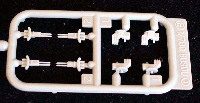 |
||||
| SPRUE F | ||||
|
This contains the triple, unshielded 25mm AA mounts. No change. This is Fujimi's new standard 25mm AA weapons fret, as included with all their new 1/700 IJN kits. I've said it before - they're ok, scale-wise and in detail. Someone building out-of-the box will be satisfied with them, no doubt. They are certainly better than what was issued on the older waterline equipment sets but these are not at all comparable to what is currently available from the FineMolds NanoDread line. |
||||
| No Image | ||||
| SPRUE G x2 | ||||
|
The first of three different sets of sprues devoted to ships boats, this sprue contains mostly larger motor launches. One of Fujimi's standardized boat sprues. No change |
||||
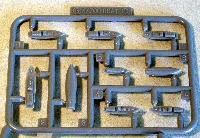 |
||||
| SPRUE I | ||||
|
This sprue contains smaller ships boats, mainly 9m cutters. This is another of Fujimi's standard boat sets. No change. |
||||
| No Image | ||||
| SPRUE J x2 | ||||
|
This is the third small sprue devoted to ship's boats consisting of 11m & 14m daihatsus, plus some very small cutters. No change. The diahatsus are very well done, more detailed than on the Tamiya Shokaku kit and as nice, or nicer, than what's seen on some of the PitRoad accessory sets. |
||||
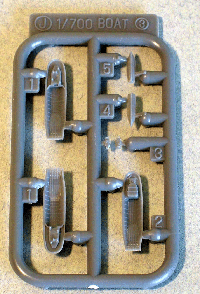 |
||||
| SPRUE M | ||||
|
A new, additional small sprue of clear plastic containing two 1/700 scale Nakajima B6N2 Jill attack planes, with separate propeller, landing gear, canopy, bomb/aerial torpedo and tail wheel. |
||||
|
||||
| SPRUE PG x2 | ||||
|
A small sprue of clear plastic containing a 1/700 scale Mitsubishi A6M2 Zero fighter, with separate propeller, landing gear, canopy, drop tank and tail wheel. No change. I'm not sure why this early war aircraft sprue is included. |
||||
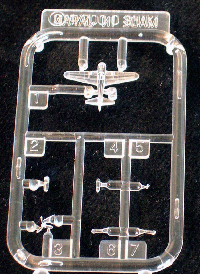 |
||||
| SPRUE PI x2 | ||||
|
A small sprue of clear plastic containing a 1/700 scale Nakajima B5N2 Kate attack plane, with separate propeller, landing gear, canopy, bomb/aerial torpedo and tail wheel. No change. Again, I'm not sure why this early war aircraft sprue is included. To the best of my knowledge, no early model Zeros or Kates were aboard Zuikaku, except, perhaps, for training purposes during that last summer. |
||||
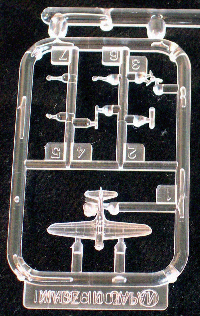 |
||||
| SPRUE PV x2 | ||||
|
A small sprue of clear plastic containing two 1/700 scale Mitsubishi A6M5 Zero fighters, with separate propeller, landing gear, canopy, drop tank and tail wheel. All aircraft have recessed panel lines. |
||||
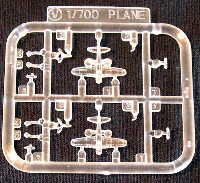 |
||||
| SPRUE Q | ||||
|
Another of Fujimi's now standard accessory sprues, it contains searchlights and two canvas coverings for larger ship's launches molded in clear plastic. No change. As stated in the Shokaku thread, the clear searchlights from the FineMolds NanoDread line are superior in detail and shape. |
||||
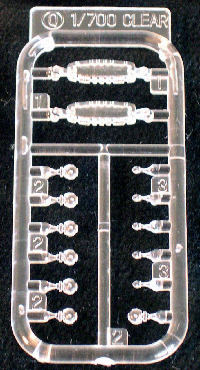 |
||||
| SPRUE R | ||||
|
This sprue contains parts for the bridge, funnel area, funnel bottoms and grills, forward and aft hangar deck bulkheads and platforms, the stern boat deck mounted supports for the aft end of the flight deck, the bases and hull mounted sponsons for the eight twin 12.7cm HA AA mounts, and some molded small boat access ladders and platforms. No change. |
||||
 |
||||
|
||||
| SPRUE S | ||||
|
This sprue holds the forecastle deck, the main boat deck at the stern, all of the 25mm AA sponsons, most of the catwalks, director platforms and walkways that append the sides of the hull. No change. |
||||
 |
||||
|
||||
| SPRUE T | ||||
|
This sprue contains the enclosed turrets and barrels for all of the enclosed AA mounts that are mounted on the starboard aft quarter, the forecastle mounted supports for the forward end of the flight deck, supports for the smaller, hull mounted 25mm AA sponsons, davits, paravanes, all the components of the four aerial radio masts, the Type 94 HA directors, anchors, and some ancillary equipment. No change. My impression of the turrets (favorable), directors and aerials (unfavorable) remain unchanged from the Shokaku review |
||||
|
||||
| SPRUE U | ||||
|
Deleted and replaced by Sprue X |
||||
|
|
||||
| SPRUE V | ||||
|
This new sprue contains 25mm AA tub halves for the new, added positions at the rear of the upper boat deck, a platform for two of the three 25mm AA mounts placed on the bow, additional crew rest compartments for these new AA positions, two Type 21 radar arrays and tubs, and some ancillary equipment. Interestingly, the additional 25mm AA platforms have nicely rendered bracing on the inside of the tubs but no stiffening ribbing on the outside, as do all of the original 25mm tubs along the flight deck in the kit. It is worth noting that the instruction illustrations do show this outer ribbing, and yet, it is non-existent. Or, so it is on my kit, at any rate. The ribbing is also present on the new, larger, 1/350 sister kits of Zuikaku and Shokaku. This is an odd, but minor omission, and correctable. The rear tub halves glue directly to the trailing edge of the upper boat deck. Neat. The forward platform is nicely detailed, including fine treading on the upper surface. The radars would benefit by replacement by PE versions, such as those that come on the corresponding Fujimi Zuikaku PE set. The crew quarters are devoid of details such as hatches and portholes save for the front facing of the main, bow compartment. |
||||
|
||||
| SPRUE W | ||||
|
Another new sprue, it contains only the 25mm AA full tubs for the bow and sternmost AA positions, along with two additional crew quarters (outer positions) for the bow mounted weapons. Again, the outside stiffening ribs are missing, as are details for the crew compartments. |
||||
|
||||
| SPRUE X | ||||
|
A sprue of both common and late war fittings that includes the upper boat deck at the stern and parts for the mainmast from Sprue U, along with the forward three bow AA platforms (including a duplicate of the platform for the forward AA on Sprue V as well as the rearmost single 25mm AA tub on Sprue W) for the additional 25mm AA positions, the two new sponsons that held the AA rocket mounts, the AA rocket mounts themselves, a cut-down walkway that mounts on the bow bulkhead of the hangar deck, a revised set of upper yardarms for the mainmast and, an elongated, enclosed compartment that went under the boat deck. As with the other decks, the boat deck treading is finely rendered, and the deck is properly shaped. Boat chocks are molded on to the deck. The original fit of the ship provided support for the upper boat deck by a number of columns and crossbeams but, early on, a center section of compartments was built under the upper deck, probably as additional crew quarters and perhaps to provide additional load bearing support. The Tamiya Shokaku class kits happen to come with this aspect molded onto the bottom of the boat deck but, that version is not as detailed. As with the original fit, the mast is divided into upper and lower halves, with bracing and platform. The upper yardarm configuration has been properly changed from straight across to a sweptback position. To repeat myself from the earlier review, I welcome the attempt at extra detailing of the mast but I feel some aspects impossible to render successfully in plastic, such as the spreaders, thereby simplified to the point of just being a block of plastic. As with the radio aerials, I think that the corresponding Fujimi PE set for Zuikaku provides a better option, as do various aftermarket PE offerings. It's either that or mast replacement by using brass rod. I find it interesting in the way the bow bulkhead walkway has been cut down on the starboard side to accommodate the addition of the AA rocket sponson that is placed in that position. It's a very smart detail, a design detail that could easily be ignored in a 1/700 kit. For that matter, I am impressed with the detail that went into the AA rocket sponsons themselves. Less impressive are the actual AA rockets. Detail is soft or non-existent. The version on the new PitRoad NE-03 IJN Equipment Accessory set is far superior. I have no idea why duplicate parts for the additional AA positions were included. Great for the spare parts bin. |
||||
|
||||
| SPRUE Y | ||||
|
Deleted. This particular sprue from the Shokaku kit held parts for two 12.7cm HA practice guns and a maneuvering observation station. All were to be placed on the rear of the upper boat deck. Understandably, the addition of more 25mm AA and crew quarters at the stern meant that the maneuvering station was removed to make room. However, one of the practice guns was retained so, hopefully, the modeler has a spare practice gun among their own spares. |
||||
|
|
||||
| SPRUE Z | ||||
|
It contains the two curved, upper halves of the two funnels. No change. |
||||
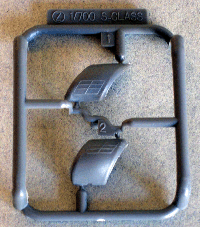 |
||||
| DECAL | ||||
|
Markings are for the late 1944 flight deck. Colors appear correct. It's a small sheet, with just some white deck striping, flight deck warning stripes that marked the position of each twin 12.7cm HA mount, and some red rondels for the aircraft. | 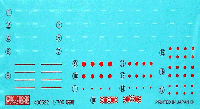
|
|||
| INSTRUCTIONS | ||||
|
This consists of eight bi-folded pages containing plan and elevation views, sprue layout, painting guide, plus several pages of exploded assembly views. There is at least one discrepancy on the instruction sheet. The painting guide illustration rightly indicates additional triple 25mm AA emplacements on the flight deck, one forward and one aft the island. However, there is no such corresponding placement indicated in the instructions themselves. The modeler will have to use the painting guide for placement. |
||||
|
||||
| CONCLUSIONS | ||||
|
My opinion from the Shokaku review is unchanged. By making use of up-to date references and slide molding technology, Fujimi has produced a superb kit that is a welcome improvement over previous kits of this ship and class. The overall level of accuracy and execution is high. I can't comment on fit at this point but my gut feeling is that this kit will build into a great model right out of the box. I personally would replace Fujimi's standard sprue sets of AA, boats, davits, mast, etc. with the superior FineMolds or PitRoad alternatives but, these are minor issues. Use of the smartly thought out Fujimi Zuikaku PE set developed in conjunction with this kit can only take the model to a finer level of detail and finish. As the Shokaku sisters are among my favorite ships, and having sweated through countless corrections of several builds using earlier kits, I make no apologies for my nitpicking, particularly of the flight deck. Most builders will not have an issue with any of the kit errors or the flight deck anomaly; in fact, the late war deck camouflage for Zuikaku renders most of these issues moot. The good news is that a modeler with average skills can handle the fixes for the more grievous errors if they so desire. For the most determined of modelers, the amount of time spent correcting this kit's errors will certainly be less than those of previous versions, as the starting point is so much finer than before. Now, both sisters have joined the ranks of modern, up to date kits. |
||||
